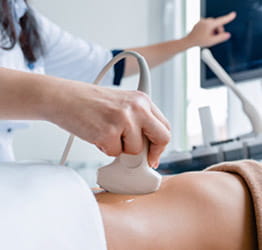Magnetic resonance imaging (MRI) is a noninvasive test that uses magnetic waves to take 2D and 3D pictures of the inside of your body. An MRI scanner can look at body parts, organs, and tissues from head to toe.
It is used to:
- Determine if current medicines or treatments are working.
- Diagnose internal injuries or conditions.
Find tumors, blood vessel diseases, internal bleeding, or infections.
Because MRI uses magnetic waves, there's no radiation exposure. At UPMC, we use the most up-to-date MRI technology, including advanced 3T MRI scanners that allow for faster scans, clearer pictures, and more precise diagnoses. Our highly trained imaging technologists are experts at assessing and capturing high-quality MRI images.
What Is MRI?
Magnetic resonance imaging (MRI) is a noninvasive test that uses magnetic waves to take 2D and 3D pictures of the inside of your body. An MRI scanner can look at body parts, organs, and tissues from head to toe. It is used to:
- Determine if current medicines or treatments are working.
- Diagnose internal injuries or conditions.
- Find tumors, blood vessel diseases, internal bleeding or infections.
Because MRI uses magnetic waves, there's no radiation exposure.
Types of MRI
MRI machines look like a large tube. They have a moveable bed where patients lay, and the bed slides into the tube during the exam. There are three main types of MRI machines, including:
- Standard bore — MRI machines with a standard-sized tube.
- Wide bore — MRI machines with a wider-than-normal tube.
- Open bore — MRI machines that are more open and can be used for people who are claustrophobic (afraid of enclosed spaces), are larger, or have trouble lying down.
Conditions we diagnose with MRI
Doctors use MRI scans to diagnose and treat health issues such as:
- Bone fractures.
- Brain trauma.
- Cancer.
- Heart and blood vessel disease.
- Joint, muscle, and bone disorders.
Why Would I Need MRI?
Your doctor may recommend an MRI to:
- Find lesions or other health problems, allowing for a more precise diagnosis.
- Diagnose and treat — with more clarity — conditions such as:
Who’s a candidate for MRI?
Most people can safely have MRI scans. However, you may not be a candidate for MRI if:
- You are claustrophobic, or afraid to be in confined spaces.
- You have any type of metal implant in your body, such as a brain aneurysm clip, artificial heart valve, pacemaker or defibrillator, inner ear implants, artificial joints, stents, or if you have worked with sheet metal in the past.
Alternatives to MRI
What Are the Risks and Complications of MRI?
MRI does not use radiation and there are no known side effects related to MRI imaging. However, there may still be some risks, including:
- Allergic reactions to contrast dye (rare).
- Problems with pacemakers and other metal implants.
What Should I Expect From MRI?
Before: How to prepare for MRI
You don't need to do anything to get ready for your MRI. You can take medicine and eat as you normally would unless your doctor tells you otherwise.
You may need a blood test a few days before your MRI to make sure you're healthy enough to have the test.
If you are anxious about your exam, your doctor may prescribe a medication called a sedative to take before your test to help you relax. If you receive sedative medication, you will need to arrange for someone to drive you home after your MRI.
How long does MRI take?
Depending on the type of scan you are having, an MRI normally takes 30-60 minutes.
During your MRI
Before your MRI starts, you'll need to complete a form that asks about your health and surgical history. Your MRI technologist will make sure you understand the questions on the form.
You'll also have a chance to ask any questions you may have about the test.
Next, you'll change into a gown and remove anything metal before you enter the MRI room, such as:
- Makeup, as some cosmetics have small amounts of metal.
- Watches or jewelry.
- Belts.
- Medicine patches.
You need to stay very still during your MRI scan to avoid blurred images. Your technologist will position you on the movable bed that slides into the scanner. Depending on your condition, you may need to wear a device to track your pulse, heart rate, and breathing.
If you're having an MRI with contrast dye, your technologist will:
- Place a small IV needle into a vein in your hand or arm.
- Give you a saline drip to prevent clotting.
- Inject the dye. Some may be allergic to the dye, but this is rare.
Next, your technologist will leave the room and:
- Slide you into the MRI scanner on the movable bed.
- Start the scan. During the scan, your technologist may give you directions — like holding your breath for short periods of time — through an intercom. Your technologist can hear you during the exam. The machine may make loud bangs and clicks. You can ask the tech for earplugs if the noise bothers you.
- Slide you out of the scanner and remove the IV needle if you had contrast dye.
- Review the images to make sure they are clear.
Recovery after MRI
If you receive medication to help you relax during the test, you will need to arrange for someone to drive you home from the imaging center. Otherwise, you should be able to drive home and resume normal activities right away.
When to call your doctor about complications
You should contact your doctor if you have any signs of infection or other complications, including:
- Severe pain, swelling, or redness at the IV site.
- Skin irritation, hives, or other symptoms of an allergic reaction. If symptoms are severe, dial 911.
Why Choose UPMC for MRI?
When you choose UPMC for MRI, you will receive:
- Access to advanced imaging technology — Our experts use the latest imaging technology to quickly and accurately diagnose and treat a full range of health conditions.
- Convenient imaging services — Imaging appointments are available at multiple locations with hours that fit your schedule.
- Multidisciplinary care — We partner with surgeons, cardiologists, oncologists, neurologists, reconstructive surgeons, and other medical experts to treat cancer and other disorders.
By UPMC Editorial Staff. Last reviewed on 2025-08-28.
















